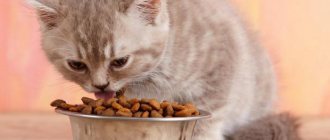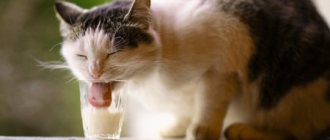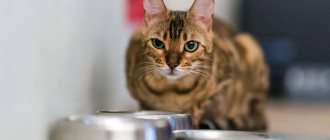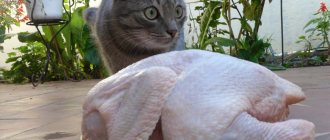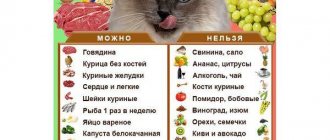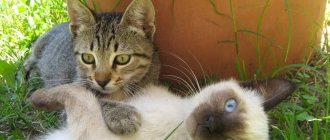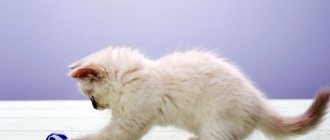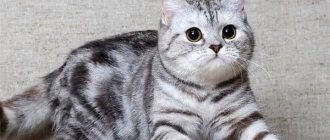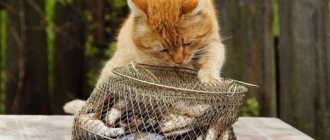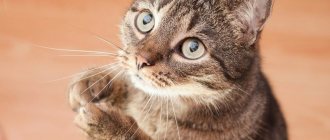Often people who have a cat and a dog at the same time are faced with the fact that their pets try each other’s food. This is normal, animals are simply not averse to “stealing” something tasty from a friend’s bowl. However, some owners are faced with a situation where the cat likes dog food and begins to eat it systematically.
Some people think that since the animal is happy with everything, then there is no need to take any action. Many people go further and buy only dog food for both pets. It usually costs less, which is an added incentive. However, a cat should not be given dog food; such food can cause various problems, since the food is intended for a different type of animal with different needs.
Relevance of the issue
Many cat owners today prefer to feed their pets prepared food. This makes life easier because it does not require the expense of searching and preparing food for the cat. It often turns out that store-bought food is cheaper than natural food.
If there are two or more animals of different species (cats and dogs) in the house, then some owners buy dog food and feed it to all pets. The fact is that dog food is often cheaper than similar cat food. In addition, the demand for dog food is lower, so retail chains and pet stores often run promotions on such products, offering significant discounts.
If we talk about treats and special devices for cleaning teeth that are given to animals to chew on, then such products are presented in a wide range in the dog version. Finding these types of treats for cats can be difficult. And the owner, sincerely confident that he wishes the cat well, gives her food for dogs.
Also, the relevance of the issue is that cats, simply by their nature, love to poke their nose into someone else's bowl. These animals are quite intelligent, and to think that they do not distinguish where whose food is is stupid. They all understand perfectly well. A cat can try dog food out of curiosity (what is it so tasty that I don’t have) or out of spite (look who’s boss), as well as for the purpose of theft (to realize the hunter’s instinct, to get prey). In addition, a cat may actually be attracted to the smell and taste of dog food and begin to prefer the neighbor's food. However, this situation cannot be allowed, since dog food is not intended for cats.
How to keep your cat safe
Cats should not be given dog food.
But if both animals live in the house, it is difficult to keep track of how often the cat eats from the other pet's bowl. To keep your animal safe, you need to follow a number of recommendations:
- It is recommended to feed the cat and dog in different rooms, but at the same time. The cat will be busy with its food and will not encroach on the dog's bowl. After feeding the animals, food must be removed immediately.
- Feed should be stored in an inaccessible place where animals cannot reach it. The smell of dog food will attract your cat, and if it finds a bag of food, it may chew through it and eat it.
- To feed a large dog, it is recommended to use special stands for the bowl so that it is located on a hill where the cat cannot reach.
If a cat has often eaten dog food, it may get used to it and refuse other food. In this case, you will have to wean your pet off the wrong diet.
Also watch the video: Can a cat get dog food, but can a kitten get cat food?
Why cats can't eat dog food
Dog food is absolutely not suitable for cats, since different types of animals have different needs. Food manufacturers know this and develop products with this in mind.
Cats are predatory animals, and, despite living for a long time next to humans, their gastrointestinal tract continues to function according to the principles characteristic of obligate predators. This means that the basis of their diet should be meat, and the digestive tract does not accept carbohydrates and coarse plant fibers well. Cats have shorter intestines and lower digestive enzyme activity. That is, the body is adapted only to digest soft meat fibers.
In dogs, the need for animal proteins is much lower; their body perfectly absorbs carbohydrates and needs them.
Dog food most often contains a fairly high percentage of grains, from which they can obtain the substances necessary for energy production. The cat's body is not able to do this. Unlike omnivorous dogs, cats must receive animal protein. And if they eat exclusively dog food, they do not receive enough essential amino acids, which over time negatively affects their health.
A deficiency of two amino acids is especially dangerous for the body: taurine and arginine. If there is a lack of the former, cats develop hypertrophic cardiomyopathy - serious damage to the heart muscle, retinal atrophy, and deterioration of the condition of the teeth and coat. The lack of the second leads to disruption of the liver, as a result of which it cannot fully utilize toxic substances. This provokes a metabolic disorder - hyperammonemia, leading to ammonia intoxication in the body.
Food intended for dogs cannot provide a cat’s body with a sufficient amount of fatty acids. In particular, it does not receive enough arachidonic acid, without which the normal functioning of the reproductive, digestive and other body systems is impossible.
Feed differences
To find out why you can’t feed cats food for dogs, you need to understand the composition of the product and the characteristics of the effect of nutrients on the animal’s body.
Dry food
There are no significant differences in appearance. The composition is different.
- Dogs need less protein, so these substances are added to food in small quantities, while cats’ bodies cannot live without this component. They slowly digest plant and grain foods, and with an improper diet they suffer from digestive disorders and other diseases.
- Cat food contains a large amount of vitamin A, which is necessary to maintain vision and normal coat condition. In dog products, this component is not enough for the normal functioning of the cat’s body. As a result, the animal becomes weaker, hair falls out, and visual acuity is impaired.
- Taurine is an essential substance for the cat's body. It is simply not available in dog products. Found naturally in meat. Taurine is responsible for the complete digestion of fats, the stability of the nervous system, blood clotting, strong immunity, and excellent heart function.
When using dog food, cats develop problems with their well-being and health, their immunity decreases, and their appearance deteriorates.
Wet food
Canned or liquid food is not intended for regular consumption by animals. Not all important components are present in their composition. In this case, the feeds do not differ much, so they cause less harm if used “incorrectly.” Nothing terrible will happen, but the cat should not be allowed to eat canned dog food regularly.
For puppies
Food products for puppies are available in dry and wet forms. They differ from adult “treats” in the amount of nutritional components. In general, the composition does not change significantly. The recipe is developed taking into account age, breed, and species characteristics. If you give puppy food to cats constantly, the animals begin to undergo biological starvation, which leads to disruption of the functioning of the digestive organs, the development of serious diseases, and fatal pathologies. Puppy food is not suitable for cats.
Proplan for Yorkies
The food was developed by veterinarians and nutritionists of the famous ]Purina[/anchor]. Each recipe was created individually, taking into account the peculiarities of the functioning of the animal’s body. Separately, products are produced for dogs, cats, puppies, and kittens. Despite the fact that the food is of high quality, it is not recommended to use it for other purposes. The reason is all in the same nutritional components, which will not be enough to maintain the normal health of the pet. The cat eats the food with pleasure, it won’t do much harm, but you can’t feed it to it all the time.
Chappie
Well-known products for dogs are of high quality and affordable prices. When buying a large bag of food, the thought involuntarily creeps into your head as to whether you should give it to your cat. Before you do this, you need to remember the following:
- Chappie dog food does not contain taurine. Cats must receive it regularly, and it comes only from the outside; it is not produced by the body itself.
- The calorie content of cat products is much higher due to the presence of fats. Metabolic processes in cats occur faster; the main source of energy is not carbohydrates, but fats. Animals eat little by little, but often. Problems arise when there is a deficiency of fat in the diet.
- Cats require vitamin A, while Chappie dog products contain more zinc and vitamin E.
There is no point in experimenting, especially since the cost of the products is approximately the same. You should not give dry dog food to your cat, and you should also abandon the idea of feeding your pet canned food for other purposes.
Possible consequences
If a cat tries dog food, there is nothing wrong with that. Nothing will happen even if she does this periodically, based on some of her own considerations. It's still not poison for cats.
Situations in which she eats exclusively dog food should not be allowed. A cat must have its own diet; this is the only way to provide its body with all the substances necessary to maintain health.
Possible consequences of constant consumption of dog food by a cat:
- obesity developing due to excess carbohydrate consumption;
- anemia, decreased overall vitality due to a lack of essential amino acids;
- taurine deficiency, leading to disturbances in myocardial function and vision impairment;
- malfunction of the digestive system.
What are the dangers of dry food?
Usually the problems do not manifest themselves too clearly, and due to the absence of easily noticeable signs, it is very difficult to immediately understand the harm of dry dog food for cats. But how exactly does this manifest itself?
Let's start with the fact that dry food is generally not the most preferable for the mustachioed fussy species. Cats often spoil their teeth in this way, wearing away the enamel on them in a short time. Moreover, such food makes the intestines work worse, because it is not entirely natural for the animal’s body, although high-quality food is well balanced. In addition, cats often gain weight from dry food.
The habit of such food, which develops quickly, is not always easy to break. It gets to the point where the mustachioed stubborn people, over time, flatly refuse to eat normal meals, blackmailing the owner with hunger strikes.
How to wean a cat off dog food
Having noticed that the cat refuses the food intended for it and prefers food from the dog bowl, the owner should take action. The animal may not understand that what seems more attractive to it in taste and smell does not meet the needs of the body. The owner’s task is to reorient the cat towards healthy food specially developed for it.
Veterinarians and felinologists recommend the following:
- give pets food in different rooms, but at the same time, so the cat will have fewer temptations;
- remove dog food from the bowl 10 minutes after feeding (if there is anything left, because dogs usually eat the entire portion without trying to save it for later);
- if the dog is a large breed, then you can purchase a special stand for it, on which the bowl will be located just below the level of the mouth (for a cat, such a height will be inaccessible).
In addition, you should review your cat's diet. After all, the fact that she eats the dog’s food may indicate that her food simply does not suit her. You need to try offering her other brands of food: both dry and wet.
In no case should a cat be given dog food if a person cares about the health of his pet. You should not give it even as a joke or as an experiment. This will make the owner’s life easier and save him from possible financial costs for treating the animal in the future.
Cats vs dogs
The eternal confrontation between the most common types of domestic animals has long been the reason for the emergence of sayings and entertaining stories. Well, dogs and cats don’t want to live together! Of course, there are enough exceptions to this rule, but still the spirit of confrontation and rivalry between these four-legged animals, which too often by the will of fate find themselves under the same roof, can rarely be completely eradicated.
It is for this reason that stealing from a dog’s bowl sometimes becomes a matter of honor for the mustachioed nimble prankster. So what is the best cat food? Sometimes it’s the one that’s in the simple-minded dog’s bowl. The hidden instinct of the hunter manifests itself in this way. It is cats who are especially guilty of predatory and unprecedented theft, apparently believing to themselves that prey is always better than the owner's handout.
About the significant difference in nutrition
At first glance, both of these representatives of the four-legged kingdom are predators, have sharp teeth and love meat, feeling the need for protein food. But dogs are omnivores, requiring a plant-based diet as well as protein. In this they are similar to people who have an urgent need for vegetables, legumes, and cereals. Unlike dogs, cats are obligate predators, that is, by nature they are designed to eat only other animals, albeit relatively small ones. They happily hunt not only mice, rats and other small rodents, but also lizards, birds and small insects. And is it possible to give a cat dog food if both types of animals mentioned above require relatively different diets for a healthy state of the body? This is where the explanation lies.
Is it possible to feed a cat dog food and a dog cat food?
Sometimes people ask veterinarians very simple questions, almost childish, and are often embarrassed about it. But in vain, because answering such questions is very interesting, and often, in order to answer them, it is necessary to describe various important things. We encourage everyone to ask absolutely any questions in the comments or in private messages to the community, without fear that they will seem stupid to us - it is quite possible , that your question will lead to the appearance of a new article in a useful blog for pet owners!
But in vain, because answering such questions is very interesting, and often, in order to answer them, it is necessary to describe various important things. We encourage everyone to ask absolutely any questions in the comments or in private messages to the community, without fear that they will seem stupid to us - it is quite possible , that your question will lead to the appearance of a new article in a useful blog for pet owners!
One of these questions is “Why do cats and dogs have different foods?” This theoretical question is interesting, if only because quite practical questions can develop from it - “Is it possible to feed a cat with dog food, or a dog with cat food?”
Let's find out!
So, you should already know from our previous articles that a dog is not a small person, and a cat is not a small dog. A cat is an obligate carnivore, that is, by definition it needs animal protein and cannot be a vegetarian. As an obligate carnivore, she needs more protein (protein, meat) in her food, and tolerates higher amounts of fat (which she also needs) than a dog. Therefore, cat foods typically contain significantly more protein and fat than dog foods.
Another very important difference between the diets of cats and dogs is taurine, the amount of which in cat food is strictly controlled, because taurine deficiency can cause taurine-dependent HCM (hypertrophic cardiomyopathy, heart disease). Dogs synthesize taurine on their own, while cats can only get it externally (although there is emerging research about the need for taurine supplements for giant breed dogs, but this issue is still being studied).
The same applies to arachidonic acid - cats do not synthesize it, they need to get it from food (and it is only found in animal products), but dogs do not need it in food.
A dog is a so-called carnivore. Once upon a time (10,000 years ago), a possible common ancestor of dogs and wolves began to live alongside humans. And the man began to live in one place, took up farming, got used to cooking carbohydrates and throwing away food waste. It was then that animals with a mutation gained an advantage, allowing them to digest starch much better than obligate predators. They were able to get much more energy from carbohydrates. These are our familiar dogs - although they remain carnivores, their level of protein requirement is much lower than that of cats.
These are the most important differences in diets. In reality, of course, there are much more differences, because the standards for the content of nutrients (amino acids, vitamins, minerals, essential fatty acids and others) are developed for each species separately, and differ for cats and dogs.
So is it possible to feed a dog cat food and a cat dog food?
First, let's clarify that we are talking about abstract healthy cats and middle-aged dogs, because with some diagnoses in the anamnesis the answer may be different.
So, within 2-3 days, both options are quite possible. Possible - does not mean that this is normal and will not have consequences (it can at least lead to diarrhea), but if it suddenly happens that you forgot to buy food in advance, and the nearest store only has cat or only dog food, and It’s night outside, then in a short time of feeding your pet with a diet not intended for its species, nothing life-threatening or irreparable will happen. The effect of deficiencies or excesses in diets in general almost always (unless it is poisoning or acute diarrhea due to a sharp increase in fat content) manifests itself very slowly, over months and years in healthy adult animals.
As for a longer period, a dog on cat food with a high degree of probability will not experience any deficiencies. But with the same degree of probability she will begin to gain weight on such a diet, since on average cat food is much higher in calories than dog food. Therefore, such feeding is, in principle, acceptable (but why?!), but with body weight control. Although it's better not to experiment.
It is not at all recommended to feed a cat dog food, since dog diets do not contain additives such as taurine and arachidonic acid. In addition, the likelihood of deficiencies in other nutrients (amino acids, vitamins, protein and fat) is also very high. Such feeding will quickly lead to serious health problems for the cat.
We hope that we were able to convincingly and reasonably answer such a seemingly simple question. 
Article on the VKontakte blog Article on the blog Article on the blog on Facebook You can download the article in pdf, epub or doc format here
